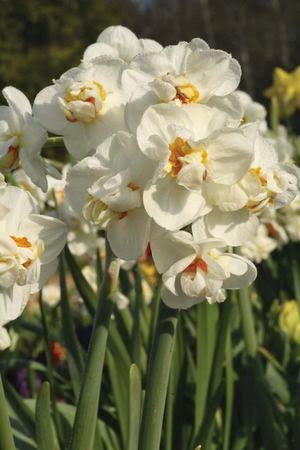8/21/2014 Ida Lee arrived at the meeting from the hotel at a little before 1pm, as the last talks were concluding. We had lunch in the University cafeteria, a very loud room with buffet style serving where the plates were weighed and we were charged by the weight, a common practice in Brazil.
Just outside the cafeteria was a very strange tree, with large coconut size fruits with a nubbly skin hanging from the trunk. We were told by one person that they were tasty, a bit like mango, but by another that they were awful, known for jumping through car windows and breaking them with no notice. We didn't try one.
After a short wait and lots of goodbyes the observatory vehicles pulled up into the parking lot for a last time and the seven glitterati were off to the airport. There was really little traffic. The final approach was by the bay, brilliantly blue on this sunny day. Alongside us was a completely empty expressway apparently made to whisk soccer crowds to the airport, only used for buses but empty today.
At the airport, Duilia led us to the checkin lane where Tommy discovered that we were early enough to get a direct flight to Foz de Iguacu rather than the two legged flight we had booked, with a four hour layover in Curitiba (7th largest city in Brazil but an airport is an airport), That cheered us up so we hurried to the gate and boarded the flight, by now just about completely full.
I gave Ida Lee my window seat up front for her middle seat halfway back and settled in. My seat mate was with some friends who had just had their law exams after graduating from UCLA. Steve said they were making their way through Brazil, having just come from Brasilia where his sister, married to a Brazilian, had just had a second marriage for the benefit of the many Brazilian cousins. After a bit under two hours, the sun setting through the smoky haze, a network of huge rivers was apparent on the ground below and we began our descent.
The airport was small so it was no time before we were on our way to the Iguassu Resort where we were staying. A huge place, all very new-looking! The rooms were eight to a bungalow, ours in 1408 on the 2nd floor. It was beautiful and spacious.
8/28/2014 This am we're seeing a purple fronted euphonia and a turquoise
honeycreeper pair in addition to a whizzing swallowtailed hummingbird
tussling with a glittering throated hummingbird and a jacobin
hummingbird over the feeders. And a Sayaca tanager pair. There are
many red rumped Caciques too. Misty and cool 60F here in the rainforest
this morning--Ida Lee crawled under the covers!
It has been my first experience living in a rainforest (though it is dry
season so rain is uncommon, though we have it today). They get 100" per
year here! These are very ancient mountains, leftovers from when South
America took leave of Africa before the end of the dinosaurs. They are
very hard granite, with very perpendicular peaks of gneiss interspersed.
The forest was mostly turned into farms over the past century. The
owner of the lodge's great grandfather built a farm here in 1907.
Nicholas started rebuilding the native habitat from the cowpastures ten
years ago. He returned a drained area to wetland, and plants 80,000
trees per year. Now it isn't an old forest but it is definitely a
forest. The birds are really interesting. One can hike several miles of
trails, going up to a thousand meters in the foothills (not me!) or just
pad around the lake, where there are hides set up for surreptitious
viewing. One fellow saw a sloth in a hillcrest tree, and there are
capybara along the pond. We saw a tayra, a SAmerican weasel, in one
rocky streambed.
Today, Ida Lee and I are here with one other guest, Derek, from S.
Africa. Tonight, we're joined by 11 others (7 Swedes). We'll depart
tomorrow after lunch.




